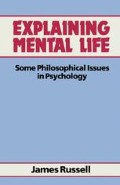Abstract
The problem of representation is: what do we think in? If this question were given to a cross-section of the population I suspect many would say ‘words’, many ‘words and images’, some ‘images only’ and a few ‘neither’. Some sensible souls would reject the question as meaningless. Some well-informed souls would refer to the controversy which raged some eighty years ago around the Würzburg functionalists’ claim that there are ‘imageless thoughts’. In fact, asking people does not get us very far at all.
Preview
Unable to display preview. Download preview PDF.
Notes and References
N. Malcolm, Memory and Mind (Ithica: Cornell University Press, 1977).
E.g. H. H. Price, Thinking and Experience (New York: Hutchinson University Library, 1953). pp. 235–6.
N. S. Sutherland, ‘Outlines of a theory of visual pattern recognition in animals and man’, Proceedings of the Royal Society, B, 171, 1968.
J. Fodor, Language of Thought (New York) (Thomas Y. Crowell Co. 1975).
H. H. Field, ‘Mental representation’, Erkenntniss, 1978, 13, pp. 9–61.
See W. V O. Quine, From a Logical Point of View (New York: Harper Torchbooks, 1953). See next chapter for a discussion of Quine’s views.
See D. Davidson, ‘Truth and meaning’, Synthese, 1967, 17, pp. 304–23.
D. M. Armstrong, Belief, Truth and Knowledge (London: Cambridge University Press, 1973).
J. M. Baldwin, The Dictionary of Philosophy and Psychology (New York: Macmillan, 1901–5).
J. Russell, ‘Propositional attitudes’, in M. Beveridge (ed.), Children Thinking Through Language (London: Edward Arnold, 1982).
A. Hannay, Mental Images: a Defence (George Allen & Unwin, 1971) pp. 16674.
This is the example used by E. Wolgast in ‘Wittgenstein and criteria’, Inquiry, 1964, 7.
J. P. Sartre, The Psychology of Imagination (London: Methuen, 1972). This is a translation of L’imaginaire which appeared in France in 1940.
R. N. Shepard and J. Metzler, ‘Mental rotation of three-dimensional objects’, Science, 1971, 171, pp. 701–03.
S. M. Kosslyn, T. M. Ball, B. J. Reiser, ‘Visual images preserve metric spatial information: evidence from studies of image scanning’, Journal of Experimental Psychology: Human Perception and Performance, 1978, 4, pp. 47–60.
S. M. Kosslyn, ‘Measuring the visual angle of the mind’s eye’, Cognitive Psychology, 1978, 10, pp. 356–89.
S. M. Kosslyn, ‘Can imagery be distinguished from other forms of internal representation? Evidence from studies of retrieval time’, Memory and Cognition, 1976, 4, pp. 291–7.
Z. W. Pylshyn, ‘The imagery debate: analogue media versus tacit knowledge’, Psychological Review, 1981, 88, pp. 16–45.
Quotes in B. Ghiselin, The Creative Process (New York: New American Library, 1952), p. 45.
S. M. Kosslyn, ‘The medium and the message in mental imagery’, Psychological Review, 1981, 88, pp. 46–66.
See the review by R. A. Finke, ‘Levels of equivalence in imagery and perception’, Psychological Review, 1980, 86, pp. 113–32.
J. R. Anderson, ‘Arguments concerning representations for mental imagery’, Psychological Review, 1978, 85, pp. 249–77.
F. Hayes-Roth, ‘Distinguishing theories of representation: a critique of Anderson, “Arguments concerning mental imagery”’, Psychological Review, 1979, 86, pp. 376–82.
Z. W. Pylyshyn, ‘Validating computational models: a critique of Anderson’s indeterminacy of representation claims’, Psychological Review, 1979, 86, pp. 383–94.
Author information
Authors and Affiliations
Copyright information
© 1984 James Russell
About this chapter
Cite this chapter
Russell, J. (1984). Representation. In: Explaining Mental Life. Palgrave, London. https://doi.org/10.1007/978-1-349-17671-7_7
Download citation
DOI: https://doi.org/10.1007/978-1-349-17671-7_7
Publisher Name: Palgrave, London
Print ISBN: 978-0-333-34324-1
Online ISBN: 978-1-349-17671-7
eBook Packages: Palgrave Religion & Philosophy CollectionPhilosophy and Religion (R0)

